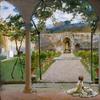Edward Bannister- In Memoriam, Past and Present
- December 07, 2010 07:15

As an art dealer I am often reminded that we are all stewards of the great history of this country; our collections are visual evidence of our links to the past. It does surprise me just how often our “links to the past” are thrust right back into the present.
Such a situation is presently developing in Providence, Rhode Island and concerns Brown University. Brown is endeavoring to preserve the memory and home of one of the nation’s most celebrated 19th century African-American artists, Edward M. Bannister. This important historical undertaking has brought to life a painting in our gallery by Bannister’s close friend George W. Whitaker (1840-1916) who completed an extraordinary painting as a tribute to fellow artist Edward Bannister more than 100 years ago.

In 1876, E. M. Bannister executed a painting Under the Oaks which was exhibited at the Philadelphia Centennial Exposition. Bannister’s painting won a first-prize medal at the exhibition, making him one of the best-known painters in New England and the first African-American artist to win widespread acclaim. The Bannister painting remains unlocated to this day, though a sketch of what it looked liked survived.
E. M. Bannister died in 1901. The first memorial to the artist was mounted by the Providence Art Club in May of that year. The Memorial Exhibition included 101 of Bannister’s paintings, with numerous paintings being loaned from the private collection of many artists of the day, including George Whitaker, who loaned five large scale canvases to the exhibit.
In 1903, two years after the death of E. M Bannister, George Whitaker completed this large scale landscape painting also titled “Under the Oaks”. Not only is the painting executed in similar size to the original Bannister work, but stylistically, this painting parallels many of E. M. Bannister’s works from the 1870’s – 1880’s period. In his painting Whitaker pays homage to Bannister with the meticulous addition of people and numerous sheep.
Though research is ongoing regarding George Whitaker’s true intention in creating his painting Under the Oaks, the date (1903), its large scale execution, and its title all indicate that this painting was a personal tribute by Whitaker to his recently deceased friend.
That a fellow artist chose to pay tribute to his friend’s importance in the Providence community with such a monumental effort in painting in 1903 is noteworthy. That the painting exists and can still tell its story is nothing short of remarkable.
















100x100_c.jpg)




